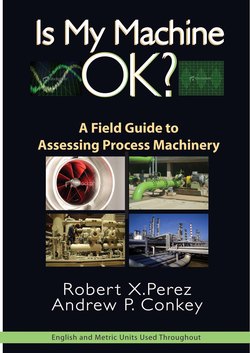Читать книгу Is My Machine OK? - Robert Perez X. - Страница 8
На сайте Литреса книга снята с продажи.
Оглавление1
Introduction
Your phone rings on the weekend at the most inopportune time. After fumbling around for your cell phone you scan the number on the caller ID and quickly realize: it’s the plant! Your internal stress meter jumps from “relaxed” to “alert.” The unfamiliar voice on the other end of the phone informs you that a critical machine at the plant is acting up and could lead to the shutdown of a major portion the plant. Your meter jumps up another notch to “high alert.” You are vaguely familiar with the piece of equipment that the caller is talking about, but you are unsure of its construction details. You know everyone is depending on you for guidance on what to do next. Now what? Where do you begin?
The purpose of this guide is to provide those who deal with industrial process machines a handy resource for assessing the potential risk of failure. It also provides a solid basis for reliable and safe machinery operation. It was developed to be taken into the field by plant supervisors, maintenance personnel, and reliability professionals so that informed decisions about their equipment can be made.
This book is made up of four sections: 1) Evaluating Process Machines, which contains basic instruction and practical advice on evaluating the condition of machines, 2) Equipment Specific Assessments, which covers the evaluation of centrifugal pumps, steam turbines, electric motors, and piping, 3) General Assessment Guidelines, which contains field assessment methods, limits, and advice commonly employed to evaluate process machinery and 4) Improvement Ideas. We have provided relevant examples throughout the book to help readers understand the proper application of the various assessment methodologies presented.
Figure 1.1 Assessing a process machine
The idea for this reference book evolved from the fact that, at the time of inception, we were not aware of a single reference that combined machinery assessment advice with established guidelines for the most commonly used machinery condition parameters, such as vibration, pulsations, temperature limits, and lubrication. Up until this guide was developed, machinery users had to identify, purchase, and maintain an expansive, as well as expensive, library of machinery books and standards to assemble a body of sound evaluation practices. For these reasons, we have endeavored to combine the assessment advice, the most commonly used assessment tools, and helpful references into one compact volume.
The reader must remember that these guidelines should not be considered absolute. Instead, they are relative starting points for machinery assessments. Criticality, machine construction, local standards, and manufacturer’s recommendations should all be factored into your final decisions and actions. By combining various guidelines into one reference, machinery owners can take a more holistic approach to machine evaluations.
We hope you find this resource a useful addition to your machinery reliability library and that it makes your job a little easier.
Robert X. Perez and Andrew P. Conkey
